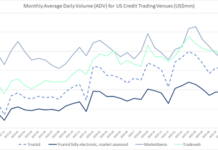Responses to the wide ranging proposals posited by the Securities and Exchange Commission (SEC) in US equity markets last week have raised questions but also positive opportunities for smaller market players.
The proposed rules set out a standard for best execution (proposed rules 6100, 6101 and 6102); changes to Reg NMS (amending Rules 610 and 612) which establishes order routing criteria; a rule requiring some retail orders to be exposed via qualified auctions to competition (proposed rule 615); and an expansion of order reporting requirements (amending rule 605). Collectively these will challenge the current model of payment for order flow (PFOF) which allow wholesale brokers to aggregate retail orders and trader them collectively into the market.

Vlad Khandros, CEO of equity alternative trading system (ATS) OneChronos says proposals which disrupt current market practices can create valuable competition in the equity space.
“The auction proposal is particularly interesting for OneChronos, as our model is competitive auctions,” he says. “The goal of the auctions is specifically to maximise the notional price improvement. So, uniquely, time is not a factor in the allocation, where most venues have price/time priority. That is what the SEC the auction proposals are trying to get away from.”
A blog by law firm Morgan Lewis, co-authored by partner Ignacio Sandoval, James Doench of Counsel and associate Kyle Whitehead, argued that, “This is perhaps the most consequential of the proposed rules and the one most likely to generate comment and controversy. It is unclear, as an initial matter, whether proposed Rule 615 solves any meaningful problem in the retail equity market other than taking away order flow from established wholesalers.”

However, says Joe Saluzzi, partner and co-founder at broker Themis Trading, preventing retail order flow from being accessed by other market participant including institutional order flow, is an issue in itself.
“Broadly I do think it will help competition,” he says. “The issue that chairman Gensler has seen is the retail flow all being segregated to the wholesaler is a problem, so he has a number of choices to make, he could ban payment for order flow, which has been done in other countries, or he could go the way he’s doing, which is to create an order competition rule, which was basically an auction model for the retail orders before they get sent to these market makers, alongside several of the other proposals which work together.”
No-one is unclear that the rules would fundamentally require current wholesale brokers who aggregate retail order flow to change their business models.
“Most platforms out there will have to totally retool what they do in order to try to get to the auction proposal,” says Khandros. “They’ll probably lose a lot of their business to do it. We’re already live with what basically looks like what the SEC seems to want to get people to do. Several of the biggest retail brokers have reached out. I could interpret that working with us is a way for them to acknowledge they don’t love everything about the proposal, but they can show they are working towards the goals of the proposal.”
Taking economist Joseph Schumpeter’s view on such disruptive rules as ‘creative destruction’, some of the changes could create new models for trading and supporting retail clients.
“A wholesale broker will have a really difficult time using their PFOF model as it is right now when they just collect payment for order flow,” says Saluzzi. “They’ll have to come up with a new way to make money, or they are going out of business or they are going to have to charge commissions, one way or the other. It will change, I think it will for the better. The more orders that interact with each other, whether they’re retail or institutional, when they’re interacting without getting segmented and parcelled by wholesalers you get a bit of a better price which is better for everybody.”
Khandros – who only joined OneChronos in October 2022 – says his team take credit for putting the firm in a position to benefit from the proposed change.
“By the end of Q1 we will have about 14 of the top 15 brokers live, which is awesome because none of them are investors,” he notes. “I say that because for major banks to connect to a brand new venue that’s not an exchange and they’re not investor is pretty unprecedented. The team has done a great job getting in front of a lot of people and educating them in advance of me joining.”
Although Themis only has institutional clients, Saluzzi notes that accessing more natural liquidity leads to better executed prices, making a net positive for his clients.
Yet there is caution advised by Morgan Lewis, who wrote that the fee-free trading on offer by some brokers and investment platforms will need to be offset if it is lost.
“While we continue to parse the proposal, it is unclear whether any price improvements that retail customers obtain under the proposed auction mechanism will be offset by their having to pay commissions if broker-dealers become reluctant to accept payment for order flow (PFOF) out of fear of violating a best execution obligation,” they wrote. “Further, given the transformative nature of the proposal, there is a significant risk that the proposed changes would lead to unintended consequences.”
©Markets Media Europe 2022
©Markets Media Europe 2025













